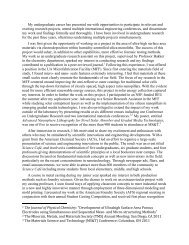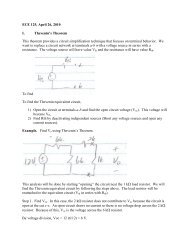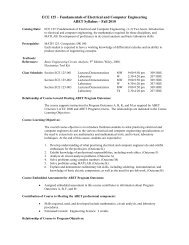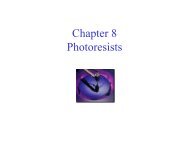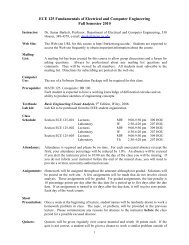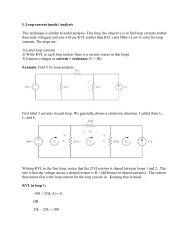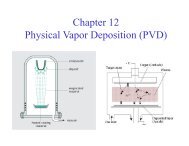ECE 131 â Fundamentals of Electrical and Computer Engineering ...
ECE 131 â Fundamentals of Electrical and Computer Engineering ...
ECE 131 â Fundamentals of Electrical and Computer Engineering ...
Create successful ePaper yourself
Turn your PDF publications into a flip-book with our unique Google optimized e-Paper software.
<strong>ECE</strong> <strong>131</strong> – <strong>Fundamentals</strong> <strong>of</strong> <strong>Electrical</strong> <strong>and</strong> <strong>Computer</strong> <strong>Engineering</strong><br />
Laboratory Report Requirements<br />
Lab Projects 1 <strong>and</strong> 5. There are no laboratory reports required for Labs 1 <strong>and</strong> 5, because these<br />
projects involve the construction <strong>of</strong> a circuit board. Your completed project for Lab 1 must be<br />
shown <strong>and</strong> demonstrated to your Lab Instructor at the beginning <strong>of</strong> your scheduled period for<br />
Lab 2. Your completed radio for Lab 5 must be shown to the Lab Instructor before the last<br />
week <strong>of</strong> the semester.<br />
Lab Projects 2, 3, <strong>and</strong> 4. A written report is required for Labs 2, 3, <strong>and</strong> 4, <strong>and</strong> the reports<br />
are due in the laboratory period that follows each lab<br />
Lab reports must be submitted as neat, legible, complete packages. All reports must be written<br />
such that an outsider with a similar technical background is able to underst<strong>and</strong> your report. Make<br />
your report as simple <strong>and</strong> to the point as practical. Although h<strong>and</strong>written reports will be<br />
accepted, it is recommended that a word processor (e.g., MS Word) be used (at least for portions<br />
<strong>of</strong> the laboratory where it makes sense). Double spacing is required so there will be room for<br />
instructor comments. Paper must not be torn from a spiral notebook. Font size should be 12<br />
point <strong>and</strong> a serif font (e.g., Times, Times New Roman, Garamond, etc.) should be used. Make<br />
sure to pro<strong>of</strong>read your report <strong>and</strong> number the pages. The report should include the following<br />
sections:<br />
Cover Page: Use a cover page then a staple to hold the papers together. The title <strong>of</strong> the report,<br />
the number <strong>and</strong> name <strong>of</strong> the course, your name, date, <strong>and</strong> signature must be on<br />
this cover page.<br />
Introduction: The introduction is intended to introduce the reader to the report. Include a<br />
sentence or two about the objective <strong>of</strong> the project <strong>and</strong> the report, one to three<br />
sentences about what you are going to tell (i.e., the contents <strong>of</strong> the report body,<br />
including conclusions).<br />
Procedure:<br />
Procedures used for making measurements should be briefly described. You can<br />
paraphrase the information in your laboratory assignment, but do not repeat<br />
(plagiarize) it. Items that are <strong>of</strong>ten helpful in this section include:<br />
• Neatly drawn circuit diagrams. These may be h<strong>and</strong> drawn using a straight edge or<br />
computer generated.<br />
• An apparatus list <strong>of</strong> the equipment <strong>and</strong> components used during the project. You must<br />
include model <strong>and</strong> serial numbers <strong>of</strong> major equipment.<br />
Results:<br />
The results <strong>of</strong> your measurements must be summarized in writing, <strong>and</strong><br />
appropriately supported with:
• Data tables must be clearly labeled so that it is obvious what parameter (e.g., circuit<br />
voltage, current, etc.) yielded which data. Each column <strong>of</strong> data should be headed by the<br />
proper unit abbreviations, such as V (for volts) or mA (for milliamperes).<br />
• Graphs can used to present data in a form that show the results obtained, as one or more<br />
<strong>of</strong> the parameters is varied. A graph has the advantage <strong>of</strong> presenting large amounts <strong>of</strong><br />
data in a concise visual form.<br />
• Relevant calculations should be shown. If repetitive calculations are needed, only show a<br />
sample calculation <strong>and</strong> summarize the others in a table.<br />
Discussion:<br />
This section is used to discuss (interpret) your results <strong>and</strong> explain any<br />
discrepancies. Answer all questions in the lab instructions that pertain to the<br />
project results.<br />
Conclusions: The Conclusions section <strong>of</strong> your report should “tell what you told.” You should<br />
very briefly summarize what you have reported <strong>and</strong> also tell the significance <strong>of</strong><br />
your results/findings.



